More Teen Behaviour
The intention or motivation to have sex is the most common predictor of an adolescent having sex and being involved in progressively riskier situations, although parental involvement and closeness has a huge impact on the choice to have sex at an early age [8]. Being at home alone also correlates with increased sexual initiation, but having good friendships is not [8].
Adolescents who believe that most of their peers have sex are more likely to have sex themselves, whereas perceived parental disapproval of sex leads to decreased sexual behavior [8]. Negative emotions towards sex or expectations of abstinence for oneself are associated with delayed initiation of sexual intercourse, as opposed to having positive or permissive attitudes towards sex which is associated with having sex [8]. This suggests that the acceptability of teenagers having sex on TV has an impact on teenagers attitudes towards sex.

Another concerning phenomenon, particularly among teenagers in the Canada, is adolescent sex parties. Krausse et al (2006) found that teens who were exposed to sex in group settings (SIGS) typically had their first sexual experience in this type of setting at 13.8 years old and had a mean lifetime number of partners of 10.7 compared to 3 for non-SIGS participants [10]. Furthermore, they found that 50% of anal and vaginal sex acts, and the majority of oral sex acts performed in these settings were unprotected. These parties tended to take place in an unsupervised apartment, involving 8 to 15 participants aged 12 to 27 years old, and usually began with sharing marijuana and alcohol prior to multiple couples having sex in one room or boys rotating from one room to another, each with a girl in it. Involvement in these parties was found to enhance a boy’s status, but damage a girl’s reputation unless she was involved only in the organization of the event [10].
Now let’s get back to the case.
_________________________________
8. Buhi, E.R., Goodson, P. Predictors of adolescent sexual behavior and intention: A theory-guided systematic review. Journal of Adolescent Health. 2007: 40;4-21.
10. Krausse, B.J., O’Day, J., Godfrey, C., Rente, K., Friedin, E., Bratt, E., Minian, N., Knibb, K., Welch, C., Kaplan, R., Saxena, G., McGinniss, S., Gilroy, J., Nwakeze, P., Curtain, S. Who wins in the status games? Violence, sexual violence, and an emerging single standard among adolescent women. Ann. N.Y. Acad. Sci. 2006: 1087; 56-73.






